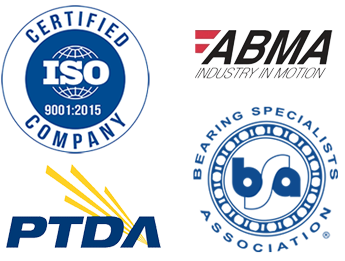Slewing ring bearings, or turntable bearings, are ball or roller-style bearings composed of two or more concentric rings, possibly including a geared diameter. The bearings enhance the load support and power transmission in all directions. They are designed to support extreme axial, radial, and tilting moment loading.
BMC understands machine/equipment failures are unpredictable, and if you don't have the backup bearings you need, you may be stuck with long-lead times, causing you costly downtime. Therefore, we provide bearing repair services that will extend bearing life and save you money. We can also help you understand if changes need to be made to your preventative maintenance program to prolong bearing life within its application.
Good repair practices start with having the knowledge and experience with these styles of bearings and custom precision equipment. In this article, we discuss the breakdown of slewing ring bearings and repairs.
Slewing Ring Bearing Applications in Different Industries
Depending on your application needs, these bearings are available in various designs and used in a wide array of industries.
The power and versatility of these bearings have made them increasingly valuable in these industries:
- Construction - supports heavy loads for slow applications and large equipment (as in construction cranes)
- Industrial - Mining, Steel, Agriculture, Oil & Gas
- Robotics equipment
- Machine tools
- Medical applications
- Aerospace & Defense
Slewing rings are designed to facilitate highly accurate support and mobility. They may have very intricate bolt hole patterns in both the inner and outer rings for easy mounting.
Compared to other rolling-element bearings, slewing bearings are relatively thin sections. They require that the structure to which they are bolted is hard enough so that under load, predefined distortion limits are not exceeded.
Three Ways to Drive a Slewing Ring Bearing
Designed similar to ball bearings, slewing ring bearings are used in rotating and turntable applications. The success of the slew ring bearings correlates to how the system is driven.
Slewing bearings are comprised of an inner and an outer ring, one of which incorporates a gear. Three ways to drive this type of bearing include external gear, external belt, and drive-plate coupling.
1. Internal & External gear - Most slewing ring manufacturers offer a geared option. The mating gear for any slew ring should be made of a softer material than the actual gear itself.
2. External belt - Belts come in various widths and the ability to withstand pounds of tension.
3. Drive-plate coupling - A drive-plate coupling connects to a motor assembled directly to the slewing ring.
Installation, Repair, of Slewing Bearing
Before installing the bearing ...
- Check the mounting surface of the main piece of machinery
- Ensure all supporting parts have sufficient strength
- The connecting surface should be machined
- The surface also must be smooth without burrs
During installation...
- Test radial positioning
- Tighten all mounting bolts (When tightening the bolts, there should be sufficient pre-tightening force, and the pre-tightening force should be 70% of the yield limit of the bolt material or to its specific torques limit set by its specific application).
- Check bearing rotation
- Any paint that is damaged during installation must be repaired. Failure in doing so could result in corrosion issues.
After installation...
- Ensure the pre-tightening torque of the mounting bolts meets the requirements
- Ensure the proper amount and type of grease/lubricant is used
- Slew bearings require the raceway to be lubricated
Repair levels can range from a complete rebuild with remanufactured components or just polished to remove high spots and burrs. Either way, the bearings are held with a magnet to ensure no added stress is placed on your product.
Precision equipment and custom manufacturing play a pivotal role too.
How to Extend the Life of Your Slewing Ring Bearings
Premature failure is a common fate for large-diameter bearings in heavy-duty applications.
However,
Regular maintenance can prevent 96% slewing ring bearing failures. To maximize bearing life, follow these tips: raceway and gear lubrication, torque checks on bolts, and seal inspection.
Most slewing bearing failures are due to lubrication problems, contamination, overloading, and improper installation and mounting fits.
Have a preventative maintenance plan that includes the bearing and be alert of these four warning signs of potential bearing problems.
1. Play in the bearing
2. Grinding, popping, or clicking noises
3. Increase in torque or binding
4. Debris particulates coming out of the seals
Most manufacturers of slewing rings have their own set of manufacturing standards, but the American Society of Mechanical Engineers (ASME) publishes the following Standard:
ASME SRB-1 on Design, Installation, Maintenance, and Application of Ball Slewing Ring BearingsConclusion
For more than 87 years, BMC has been the go-to provider of top-quality roller and ball bearings for customers globally. We quickly provide the best bearing solution for your application.
We are dedicated to providing our customers with the correct bearings at competitive prices.
To learn more about BMC's services, bearing products, solutions, and repairs, contact us today or get a quote on your bearings project.

.png)



